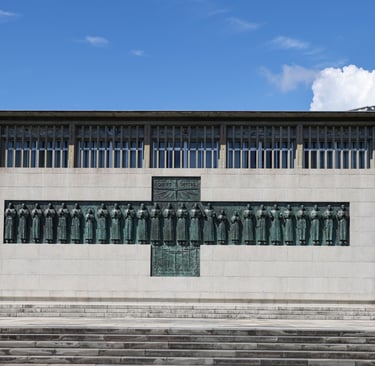Why Japan Banned Christianity
—The Background, History, and Eventual Reopening—
11/7/20252 min read


In the mid-16th century, Christianity was introduced to Japan for the first time. In 1549, Francis Xavier arrived in Kagoshima, marking the beginning of Christian missionary work in the country. The new faith spread rapidly, especially in Kyushu, and within a few decades the number of believers had reached hundreds of thousands. However, Japan eventually came to regard this foreign religion as a threat, and by the early 17th century, Christianity was completely banned. Why did Japan make such a drastic decision?
The Background: Tension Between Politics and Religion
At the time, Japan was in the final years of the Sengoku (Warring States) period. Many feudal lords benefited from trade with Portugal and Spain, known as the Nanban trade. The missionaries brought not only religion but also the latest Western knowledge and technology, and at first Christianity was seen as a symbol of civilization.
As missionary work expanded, however, Christianity began to interfere with political authority. Some Christian daimyō forced their subjects to convert and destroyed Buddhist temples, which led to social unrest. Seeing this as a potential threat to national unity, Toyotomi Hideyoshi issued the “Bateren Expulsion Edict” in 1587. This marked the beginning of Christian persecution in Japan.
The Tokugawa Shogunate’s Ban and Persecution
Under Tokugawa Ieyasu, the founder of the Edo shogunate, the government initially tolerated Christianity for economic reasons. But as reports spread of Spain and Portugal colonizing vast regions in Asia and South America, suspicion grew that missionaries were paving the way for foreign conquest.
In 1612, the Tokugawa government issued an official ban on Christianity, and strict nationwide suppression followed. Believers were forced to trample on Christian images in the infamous fumi-e tests, and those who refused were tortured or executed. Particularly harsh crackdowns occurred in Nagasaki and the Shimabara-Amakusa region, culminating in the Shimabara Rebellion of 1637. The uprising, led mainly by Christian peasants, was brutally crushed, and Christianity was banned for over 200 years.
The Hidden Christians
Even under severe persecution, some believers secretly continued their faith. Known as Kakure Kirishitan (“Hidden Christians”), they disguised their religion under Buddhist practices, praying in secret and passing down their faith orally. Statues of the Virgin Mary were altered to resemble Kannon (the Buddhist goddess of mercy), and prayers (called orasho) were memorized and transmitted in secret. In this way, Christianity survived underground for centuries, quietly preserved in the hearts of its followers.
The Reopening and Legalization of Christianity
In the mid-19th century, after Commodore Perry’s arrival, Japan ended its long isolation and reopened to the world. Missionaries returned in 1859 and built churches in port cities like Yokohama and Nagasaki. At first, these churches served only foreigners, but soon Japanese believers appeared as well.
In 1865, the famous “Discovery of the Hidden Christians” occurred at the Oura Cathedral in Nagasaki, where descendants of secret believers revealed their faith to French priest Bernard Petitjean. This moving event drew international attention, and in 1873, the Meiji government officially lifted the ban on Christianity.
Conclusion
Japan’s ban on Christianity was not simply a matter of religious intolerance—it reflected deep political fears and anxiety about foreign influence. Yet, even under oppression, people continued to protect their faith in secret. Their quiet resilience remains one of the most moving stories in Japanese history.
Today, churches stand freely across the country, and the “Hidden Christian Sites in the Nagasaki Region” are recognized as a UNESCO World Heritage Site. The faith that was once forbidden has found its light again, symbolizing a powerful story of endurance and spiritual freedom.
